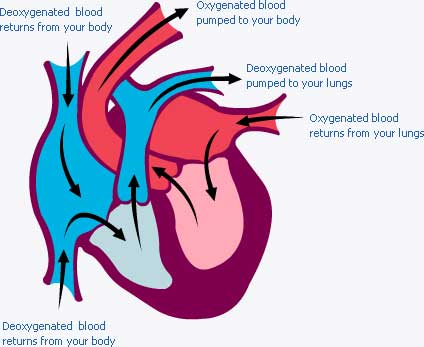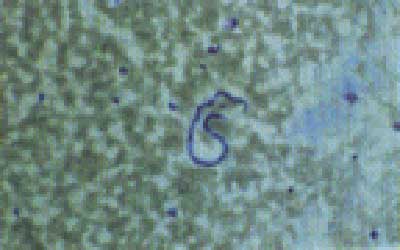Heartworm Facts
Heartworm (Dirofilaria immitis) is a fairly large worm, up to 14 inches long, that in adulthood lives in the heart and pulmonary arteries of an infected dog. Dogs acquire this infection through mosquito bites as mosquitoes readily pick up larval heartworms from infected dogs and carry them to new dogs. Some geographic areas have severe heartworm problems while other areas have virtually none. In order for the parasite to establish its presence in an area, the following conditions must be met:
- Types of mosquitoes capable of carrying larval heartworms must be present.
- The weather must be warm enough to allow heartworm larval development within the mosquito.
- There must be infected dogs (or coyotes) in the area.
- There must be vulnerable host dogs in the area.
When these conditions come together, an area becomes endemic for heartworm disease.
The detailed version of the heartworm story: Let's follow the worm's life cycle
The Adult Heartworm
Blood going to the lung to pick up oxygen is received first by the right atrium of the heart, then sent to the right ventricle (the pumping chamber), and then sent out to the lung via the pulmonary arteries. This path is outlined in the blue pathway in the graphic below.

If the worm infection is a heavy one (over 25 worms for a 40 lb dog), the worms begin to back up into the heart's right ventricle (the chamber which pumps blood through the lung). The adult heartworm is fairly large, several inches in length, and it prefers to live, not in the heart, but in the pulmonary arteries. It swims into a cozy tubular artery, where it is massaged and nourished by the blood coursing past it. In the pulmonary arteries of an infected dog, the worm's presence generates a strong inflammatory response and a tendency for blood to inappropriately clot. If enough worms are present, the heart must work extra hard to pump blood through the plugged-up arteries.
 The worms actually take up a significant amount of space within the heart, space that could have been taken up by the blood. With less blood going through the heart, there is less blood being pumped out to the lung.
The worms actually take up a significant amount of space within the heart, space that could have been taken up by the blood. With less blood going through the heart, there is less blood being pumped out to the lung.
When over 50 worms are present, the ventricle is completely full and the atrium, the chamber receiving blood from the rest of the body, begins to fill with worms.
When over 100 worms are present, the entire right side of the heart is filled with worms and there is very little room for any blood to be pumped. This drastic phenomenon is called "Caval Syndrome" and most dogs do not survive it.
Microfilariae (First Stage Larvae)
With adult male and female worms present, mating begins to occur. Heartworms do not lay eggs like other worm parasites; instead, they give live birth and the baby worms are called microfilariae.
Microfilariae are released into the circulatory system in hopes that they will be slurped up by a mosquito taking a blood meal and carried to a new host. Microfilariae may live up to two years within the host dog in whom they were born. If, after this period, a mosquito has not picked them up, they die of old age. Microfilariae may also be transmitted across the placental barrier to unborn puppies if the mother dog is infected with heartworm. It is important to realize that such puppies will not develop adult heartworms or heartworm disease from these microfilariae; in order for a heartworm to reach adulthood, it must be passed through a mosquito.

Microfilariae in a blood smear
Parasitic worms have 5 larval stages and are termed L1, L2, L3, etc. Heartworm microfilariae are first-stage larvae: L1s.
Note: Ivermectin and milbemycin-based heartworm preventives will kill microfilariae after prolonged use. Dogs on these heartworm preventives, even if infected with adult heartworms, will not test positive for microfilariae. Moxidectin-based heartworm preventives (Advantage Multi®) and selamectin-based heartworm preventives (Revolution®) will not reliably wipe out microfilariae; infected dogs who have received these products may or may not test positive.
Inside the Mosquito
So, let us continue to follow the young heartworm's development inside the mosquito that has taken it in with a blood meal. Within the mosquito's body, the microfilariae will develop to L2s and finally to L3, the stage capable of infecting a new dog. How long this takes depends on the environmental conditions. In general, it takes a few weeks. A minimum environmental temperature of 57 degrees F is required throughout this period. The process goes faster in warmer weather.
Infecting a New Dog
When a dog is bitten by an infected mosquito, the L3 is not deposited directly into the dog's bloodstream. Instead, it is deposited in a tiny drop of mosquito "spit" adjacent to the
mosquito bite. For transmission to occur there must be adequate humidity to prevent evaporation of this fluid droplet before the L3s can swim through the mosquito bite and into the new host.
 Once safely inside the new host, the L3 will spend the next week or two developing into an L4 within the host's skin. The L4 will live in the skin for three months or so until it develops to the L5 stage and is ready to enter the host's circulatory system. The L5, which is actually a young adult, migrates to the heart and out into the pulmonary arteries (if there is room) where it will mate, approximately 5 to 7 months after first entering the new host.
Once safely inside the new host, the L3 will spend the next week or two developing into an L4 within the host's skin. The L4 will live in the skin for three months or so until it develops to the L5 stage and is ready to enter the host's circulatory system. The L5, which is actually a young adult, migrates to the heart and out into the pulmonary arteries (if there is room) where it will mate, approximately 5 to 7 months after first entering the new host.
 Note: All commercially available heartworm preventives act by wiping out the freshly delivered L3's and the L4's living in the skin. The ivermectin products are also able to kill the younger L5's.
Note: All commercially available heartworm preventives act by wiping out the freshly delivered L3's and the L4's living in the skin. The ivermectin products are also able to kill the younger L5's.
Also note: because the heartworm tests on the market either look for microfilariae or for adult worm proteins, they will not detect infection with immature worms. This is why it takes at least 5 months from the time of exposure to get a valid heartworm test and this is also why there is no point in testing puppies less than 6 months of age.
Information provided by VeterinaryPartner

